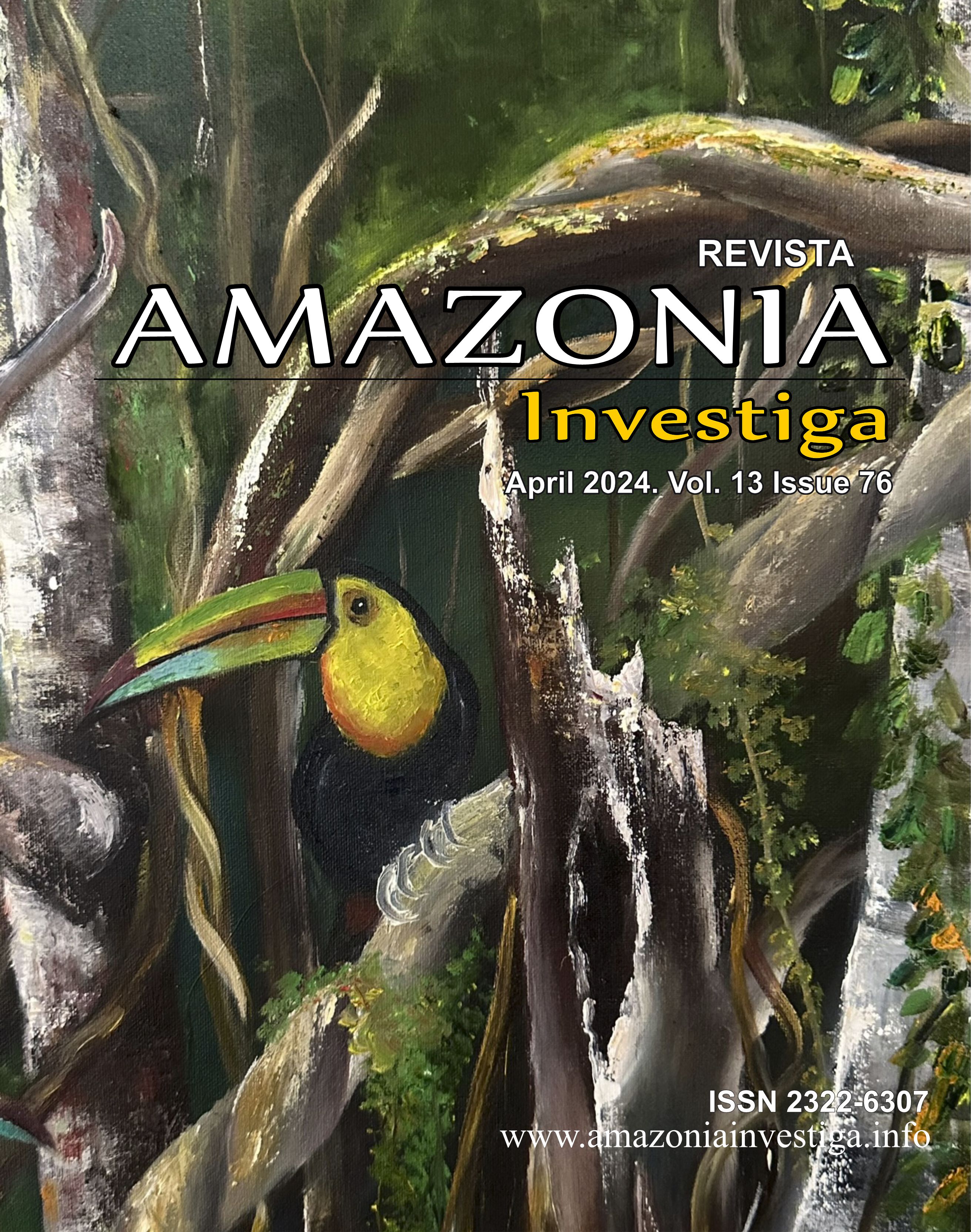Implementation of innovative information technologies in judicial proceedings: organizational and legal aspect
Publicado 2024-04-30
Palabras clave
- judicial system, organizational and legal support, legal regulation, information technologies, digitalization, artificial intelligence, European integration, international experience, smart technologies, court.
Cómo citar
Derechos de autor 2024 Amazonia Investiga

Esta obra está bajo una licencia internacional Creative Commons Atribución 4.0.
Resumen
This work aims to study the organizational and legal aspects of implementing the latest information technologies (IT), including artificial intelligence (AI), in the justice system. The study was based on a comprehensive approach that integrated analytical methods, comparative analysis, the case study method, and risk assessment. It is determined that to improve the existing regulatory framework on the use of IT in the judicial system, it is necessary to regulate the following organizational and legal aspects: I. enshrine compliance with ethical principles, ensure information security, and define responsibility for the risks of using AI systems at the legislative level; II. develop unified standards and requirements for algorithms, models, and data used in AI systems that support the information activities of courts; IV. provide proper guarantees for respect for human rights, prevention of discrimination and bias in the use of AI in legal proceedings; V. ensure transparency of legal regulation, which will increase public confidence in the use of AI technologies in the judicial system; VI. ensure flexibility and adaptability of legal regulation, and promote harmonization of the regulatory framework at the international level through the adoption of generally accepted principles and unified standards for the use of AI systems.
Descargas
Citas
- Ablamskyi, S., Tchobo, D. L., Romaniuk, V., Simic, G., & Ilchyshyn, N. (2023). Assessing the Responsibilities of the International Criminal Court in the Investigation of War Crimes in Ukraine. Novum Jus, 17(2), 353-374.
- Alcántara Francia, O.A., Nunez-del-Prado, M., & Alatrista-Salas, H. (2022). Survey of Text Mining Techniques Applied to Judicial Decisions Prediction. Applied Sciences, 12(20), 10200. https://doi.org/10.3390/app122010200
- Alghazzawi, D., Bamasag, O., Albeshri, A., Sana, I., Ullah, H., & Asghar, M.Z. (2022). Efficient Prediction of Court Judgments Using an LSTM+CNN Neural Network Model with an Optimal Feature Set. Mathematics, 10(5), 683. https://doi.org/10.3390/math10050683
- Berezka, K., Kovalchuk, O., Banakh, S., Zlyvko, S., & Hrechaniuk, R. (2022). A Binary Logistic Regression Model for Support Decision Making in Criminal Justice. Folia Oeconomica Stetinensia, 2(1), 1-17. https://doi.org/10.2478/foli-2022-0001
- Bosley, J.S., Capell, J.M., Kinaga, P., & LeCrone, J.P. (2023). California Proposed Employment AI Regulations and Legislation. Davis Wright Tremaine LLP. URL: https://acortar.link/GjMPCr
- Canaan, R.G. (2023). AI Regulation in Canada: Protective and Innovation-Enabling. RAILS. URL: https://acortar.link/W7EYEN
- Demertzis, K., Rantos, K., Magafas, L., Skianis, C., & Iliadis, L. (2023). A Secure and Privacy-Preserving Blockchain-Based XAI-Justice System. Information, 14(9), 477. https://doi.org/10.3390/info14090477
- Dumouchel, P. (2023). AI and Regulations. AI, 4, 1023-1035. https://doi.org/10.3390/ai4040052
- Gkougkoudis, G., Pissanidis, D., & Demertzis, K. (2022). Intelligence-Led Policing and the New Technologies Adopted by the Hellenic Police. Digital, 2, 143-163. https://doi.org/10.3390/digital2020009
- Goncharuk, N., & Bielova, A. (2022). The current state of organizational, legal and personnel support for the activities of local courts in the conditions of the Europeanization of the judicial administration system in Ukraine. Aspects of public administration, 10(4), 5-12. https://doi.org/10.15421/152221
- Heng, T.B. (2023). E-litigation: The Singapore Experience. Focus. URL: https://v1.lawgazette.com.sg/2001-11/Nov01-focus2.htm
- Ho, J.-H., Lee, G.-G., & Lu, M.-T. (2020). Exploring the Implementation of a Legal AI Bot for Sustainable Development in Legal Advisory Institutions. Sustainability, 12, 5991. https://doi.org/10.3390/su12155991
- Kurth, A. (2023). UK Government Publishes AI White Paper. Hunton. URL: https://acortar.link/u8u53w
- James, W. (2020). UK Supreme Court switches to video conferencing. Reuters. URL: https://acortar.link/LX8gl2
- Kaur, G. (2023). Singapore makes key policy shifts in revised national AI strategy. Computerworld. URL: https://acortar.link/kJpoBA
- Kibenko, O. (2023). The future of online courts in Ukraine: digitization of existing processes or digital transformation of justice?. Legal Newspaper, 1-2, 759-760. URL: https://acortar.link/6moavj
- Kovalchuk, O., Banakh, S., Masonkova, M., Berezka, K., Mokhun, S., & Fedchyshyn, O. (2022). Text Mining for the Analysis of Legal Texts. Proceedings of the 12th International Conference on Advanced Computer Information Technologies (pp. 502-505). Ruzomberok, Slovakia: IEEE. https://doi.org/10.1109/ACIT54803.2022.9913169
- Kovalchuk, O. Karpinski, M., Banakh, S., Kasianchu,k M., Shevchuk, R., & Zagorodna, N. (2023). Prediction Machine Learning Models on Propensity Convicts to Criminal Recidivism. Information, 14(3), 161. https://doi.org/10.3390/info14030161
- Kovalchuk, O., & Teremetskyi, V. (2023). Informational and Legal Support of the Justice System. Scientific notes. Series: Law, 15, 271-278. URL: https://pravo.cusu.edu.ua/index.php/pravo/article/view/378/397
- Law of Ukraine No. 3262-IV. On Access to Court Decisions. Bulletin of the Verkhovna Rada of Ukraine, Kyiv, Dec 22, 2005. URL: https://cis-legislation.com/document.fwx?rgn=10165
- Law of Ukraine No 1416-IX. On Amendments to Certain Legislative Acts of Ukraine Concerning the Gradual Implementation of the Unified Judicial Information and Telecommunication System from Apr. 27, 2021. Holos Ukrainy – Voice of Ukraine. URL: https://zakon.rada.gov.ua/laws/show/1416-20#Text
- Law of Ukraine No. 1200/0/15-18. On Approval of the Procedure for Maintaining the Unified State Register of Court Decisions: Decision of the High Council of Justice. Bulletin of the Verkhovna Rada of Ukraine, Kyiv, Apr 19, 2018. URL: https://zakon.rada.gov.ua/rada/show/v1200910-18#Text
- Ma, L., Zhang, Y., Wang, T., Liu, X., Ye, W., Sun, C., & Zhang, S. (2021). Legal Judgment Prediction with Multi-Stage Case Representation Learning in the Real Court Setting. In Proceedings of the 44th International ACM SIGIR Conference on Research and Development in Information Retrieval, Virtual (pp. 993-1002). https://doi.org/10.1145/3404835.3462945
- Maakohtu, H. (2023). A step towards the digital future - how is justice administered in Estonia? The Estonian IT Centre. URL: https://rit.ee/en/news/step-towards-digital-future-how-justice-administered-estonia
- Maruyama, M., & Nicola, C. (2022). Recent Updates On Japan’s National Strategy On AI. Eu-Japan.AI. URL: https://www.eu-japan.ai/ja/recent-updates-on-japans-national-strategy-on-ai/
- Mathis, B. (2022). Extracting Proceedings Data from Court Cases with Machine Learning. Stats., 5(4), 1305-1320. https://doi.org/10.3390/stats5040079
- Münch, L.A.C., & Ferraz, T.S. (2024). Exploring Defuturing to Design Artificial-Intelligence Artifacts: A Systemic-Design Approach to Tackle Litigiousness in the Brazilian Judiciary. Laws, 13(1), 4. https://doi.org/10.3390/laws13010004
- OECD. (2019). Recommendation of the Council on Artificial Intelligence. OECD Legal Instruments. URL: https://legalinstruments.oecd.org/en/instruments/oecd-legal-0449
- Park, M., & Chai, S. (2021). AI Model for Predicting Legal Judgments to Improve Accuracy and Explainability of Online Privacy Invasion Cases. Applied Sciences, 11(23), 11080. https://doi.org/10.3390/app112311080
- Pavlyuk, I. Yu. (2020). Legal principles of organizational ensuring the activities of commercial courts. Legal Science, 3(105), 251-257. https://doi.org/10.32844/2222-5374-2020-105-3.32
- Povydysh, V., Kobko, Y., Svyrydenko, S., Nironka, I., & Dobroskok, A. (2023). Information and analytical support for the State defense order in Ukraine. Amazonia Investiga, 12(65), 59-67. https://doi.org/10.34069/AI/2023.65.05.6
- Ramos, G. (s.f). Ethics of Artificial Intelligence. UNESCO. URL: https://www.unesco.org/en/artificial-intelligence/recommendation-ethics
- Reiling, D., & Contini, F. (2022). E-Justice Platforms: Challenges for Judicial Governance. International Journal for Court Administration, 13(1), 6. https://doi.org/10.36745/ijca.445
- Sajida, T.K., Zakir, M.Y., Khan, T., & Khan, S.H. (2023). Nurturing Rehabilitation and Reintegration of Youth Offenders in the Pakistani Justice System: An Analysis of Juvenile Probation Officers. Journal of Asian Development Studies, 12(4). URL: https://poverty.com.pk/index.php/Journal/article/view/267
- Shaikh, R.A., Sahu, T.P., & Anand, V. (2020). Predicting Outcomes of Legal Cases based on Legal Factors using Classifiers. Procedia Computer Science, 167,2393-2402. https://doi.org/10.1016/j.procs.2020.03.292
- Shetty, V.R., Pooja. R., & Malghan, R.L. (2023). Safeguarding against Cyber Threats: Machine Learning-Based Approaches for Real-Time Fraud Detection and Prevention. Engineering Proceedings, 59(1), 111. https://www.mdpi.com/2673-4591/59/1/111
- Svitlychnyi, O.P. (2023). Organizational Ensuring the Activities of Commercial Courts. Legal Scientific Electronic Journal, 3, 344-347. https://doi.org/10.32782/2524-0374/2023-3/80
- Taddeo, M., & McNeish, D., Blanchard, A., & Edgar, E. (2021). Ethical Principles for Artificial Intelligence in National Defence. Philosophy & Technology, 34(886), 1-23. http://doi.org/10.1007/s13347-021-00482-3
- Teremetskyi, V., Boiko, V., Malyshev, О., Seleznova, О., & Kelbia, S. (2023). Electronic Judiciary in Ukraine: Problems of Implementation and Possible Solutions. Amazonia Investiga, 12(68), 33-42. https://doi.org/10.34069/AI/2023.68.08.3
- Teremetskyi, V. I., & Duliba, YE.V. (2023). Peculiarities of Implementation and Functioning of the Unified Judicial Information and Telecommunication System as an E-Justice Tool. Forum Prava, 75(2), 130-143. https://doi.org/10.5281/zenodo.7947514
- Tu, M., Dall'erba, S., & Ye, M. (2022). Spatial and Temporal Evolution of the Chinese Artificial Intelligence Innovation Network. Sustainability, 14, 5448. https://doi.org/10.3390/su14095448
- Turkanova, V. (2023). Prospects for the use of artificial intelligence and machine learning algorithms for effective resolution of civil disputes. Access to Justice in Eastern Europe, 2(19), 1-10. https://doi.org/10.33327/AJEE-18-6.2-n000224
- Yu, H., Liu, L., Yang, B., & Lan, M. (2020). Crime Prediction with Historical Crime and Movement Data of Potential Offenders Using a Spatio-Temporal Cokriging Method. ISPRS international journal of geo-information, 9(12), 732. https://doi.org/10.3390/ijgi9120732
- Zheng, G. (2020). China’s Grand Design of People’s Smart Courts. Asian Journal of Law and Society, 7(3), 1-22. https://doi.org/10.1017/als.2020.20











